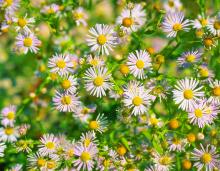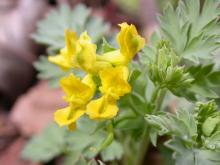Wildflowers, Grasses and Other Nonwoody Plants
Media

Species Types
Scientific Name
Impatiens pallida
Description
Our two Missouri jewelweeds occur in the same habitats, often side by side, and even botanists can’t tell them apart without the flowers. Pale touch-me-not is the one with the lemon-yellow flowers!
Media

Species Types
Scientific Name
Lythrum salicaria
Description
Anyone who’s seen what purple loosestrife has done to New England and the Northeast can tell you how invasive this plant is. Learn how to identify it, so you can report any findings to the Missouri Department of Conservation.
Media

Species Types
Scientific Name
Trifolium stoloniferum
Description
Running buffalo clover spreads by sending out long, creeping runners. Now endangered, this native perennial once flourished along streams and buffalo trails throughout the grasslands of the eastern and central United States.
Media

Species Types
Scientific Name
Stylophorum diphyllum
Description
The showy, bright yellow flowers of celandine poppy really stand out in the shady woods and valleys where this plant grows. You should consider this species when you are planting a shade garden!
Media

Species Types
Scientific Name
Boltonia decurrens
Description
A big river floodplain species, decurrent false aster has declined as wetlands have been drained and converted to agricultural crop production.
Media

Species Types
Scientific Name
Corydalis flavula
Description
The smooth, finely divided, fernlike foliage of pale corydalis is similar to that of the related wildflower Dutchman’s breeches. But in pale corydalis, the small yellow flowers appear tubelike and lipped.
Media

Species Types
Scientific Name
Delphinium tricorne
Description
Dwarf larkspur is a single-stemmed perennial with an upright flower stalk bearing racemes of bluish-purple flowers. Like other larkspurs, there is a spurlike appendage behind each flower.
Media

Species Types
Scientific Name
Polygonatum biflorum
Description
Solomon's seal grows statewide in moist, rich earth. The greenish-white flowers dangle like little bells beneath the leaves, under the gracefully arching stems.
Media

Species Types
Scientific Name
Melilotus albus and M. officinale
Description
These two species of sweet clover are present all over America. Although they have been planted for forage, as bee plants, and as nitrogen-fixers, white and yellow sweet clover are now classified as invasive for their weediness and the problems they pose for natural habitats.
Media

Species Types
Scientific Name
Dicentra cucullaria
Description
Dutchman’s breeches, a common spring wildflower, is easy to identify. Note its bluish-green, fernlike leaves and its leafless stalks, from which dangle several white flowers shaped like old-fashioned knee breeches.
See Also
About Wildflowers, Grasses and Other Nonwoody Plants in Missouri
A very simple way of thinking about the green world is to divide the vascular plants into two groups: woody and nonwoody (or herbaceous). But this is an artificial division; many plant families include some species that are woody and some that are not. The diversity of nonwoody vascular plants is staggering! Think of all the ferns, grasses, sedges, lilies, peas, sunflowers, nightshades, milkweeds, mustards, mints, and mallows — weeds and wildflowers — and many more!





















